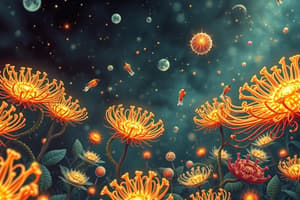Podcast
Questions and Answers
How do protozoa reproduce?
How do protozoa reproduce?
- By forming spores that develop into new individuals
- Sexually through binary fission (correct)
- Only asexually through binary fission
- By exchanging genetic material through osmosis
What distinguishes protozoa from other microorganisms in the kingdom Protista?
What distinguishes protozoa from other microorganisms in the kingdom Protista?
- Their ability to reproduce both sexually and asexually (correct)
- Their photosynthetic capabilities
- Their lack of a nucleus
- Their large size compared to other microorganisms
Why are protozoa crucial for various ecosystems?
Why are protozoa crucial for various ecosystems?
- They produce oxygen through photosynthesis
- They are the primary predators of larger organisms
- They form symbiotic relationships with larger organisms
- They consume dead plant matter and break down waste products (correct)
What size range do protozoa typically fall within?
What size range do protozoa typically fall within?
In what way do some protozoans exhibit sexual reproduction aside from binary fission?
In what way do some protozoans exhibit sexual reproduction aside from binary fission?
What is one defining characteristic of protozoan cells?
What is one defining characteristic of protozoan cells?
Which protozoan uses pseudopods for movement?
Which protozoan uses pseudopods for movement?
How do protozoans capture food particles?
How do protozoans capture food particles?
What is a characteristic feature of Paramecium among protozoa?
What is a characteristic feature of Paramecium among protozoa?
How do protozoans generate energy?
How do protozoans generate energy?
Flashcards are hidden until you start studying
Study Notes
Kingdom Protista: A World of Unicellular Organisms
The kingdom Protista is often overlooked when discussing life forms due to its seemingly mundane nature compared to other domains such as Bacteria and Archaea. However, this kingdom contains some of the most diverse and fascinating creatures found within the realm of biology, known as protozoans. These tiny, single-celled entities have been around since the dawn of time, exhibiting a variety of unique traits that make them truly remarkable.
What Are Protozoa?
Protozoa refers specifically to certain groups of microorganisms within the kingdom Protista. They can reproduce both sexually and asexually through binary fission, which involves dividing their cytoplasm into two equal parts. Some protozoans also exhibit a form of sexual reproduction called conjugation, where they exchange genetic information with another member of their species. This allows them to adapt and evolve rapidly in response to environmental changes.
These organisms range in size from 1 to 20 micrometers (μm), making many visible only under a high magnification lens. Despite their small stature, they play vital roles in various ecosystems by consuming dead plant matter, breaking down waste products, and even preying upon other tiny organisms like bacteria. Their presence is crucial for maintaining ecological balance and recycling essential nutrients back into the environment.
Characteristics of Protozoa
One defining characteristic of protozoan cells is the absence of cell walls, giving them flexibility in terms of shape and movement. Many protozoans possess flagella or cilia, hairlike structures that help them move through their environments by either whipping back and forth (flagella) or working together to create gentle currents of water flow (cilia). These movements allow protozoans to capture food particles, such as bacteria, algae, or even smaller protozoans themselves, using specialized feeding structures like pseudopods or phagocytosis.
Another feature common among protists is their ability to carry out photosynthesis, a process typically associated with plants but performed here without chlorophyll—they are often referred to as prochlorophytes. This means they can generate their own energy via sunlight and carbon dioxide, similar to how plants do it, providing them with an advantage over other types of heterotrophs who rely solely on ingesting organic material for sustenance.
Examples of Protozoa
Some well-known examples of protozoa include Amoeba, Paramecium, Euglena, Giardia, and Trypanosoma. Each has distinct characteristics that set them apart from one another:
- Amoeba: Known for its fluid-filled body cavity and power of locomotion, amoebas utilize a structure called a pseudopodium, forming temporary extensions that change direction frequently while moving across surfaces.
- Paramecium: One of the largest protozoa, paramecia display ciliary movement used for propulsion and feeding.
- Euglena: Photoautotrophic, meaning these motile organisms contain chlorophyll pigments that facilitate photosynthetic reactions.
- Giardia: An intestinal parasite commonly transmitted through contaminated drinking water, giardiasis causes diarrhea and abdominal cramps in humans.
- Trypanosoma: Transmitted through infected bloodsucking insect bites, trypanosomes cause diseases like African sleeping sickness, Chagas disease, and leishmaniasis.
Evolutionary Significance
In evolutionary history, protozoa played a significant role in the development of multicellular life forms. Fossil evidence suggests that some groups of these ancient single-celled organisms gave rise to more complex, multi-cellular beings through processes such as symbiosis and endosymbiosis. This transformation allowed for further diversification and adaptation among living things, ultimately leading up to present-day animals, plants, fungi, etc.
Moreover, the study of protists provides valuable insights into cellular mechanisms shared amongst eukaryotes; understanding these shared features helps researchers gain knowledge about human health issues related to cell division errors, aging, and cancer. As such, studying protozoa continues to contribute significantly to our overall understanding of life itself.
Conclusion
Despite being relatively simple in appearance, kingdom Protista houses a world of complexity and biological wonder. From their intricate feeding habits to their pivotal roles in ecosystems and human health, protozoans demonstrate the incredible diversity and interconnectedness of all life forms on Earth. So next time you take a sip of water or pick up a leaf, remember there's likely a whole community of microscopic inhabitants swimming, crawling, or floating nearby – all part of the grand tapestry of life we call nature.
Studying That Suits You
Use AI to generate personalized quizzes and flashcards to suit your learning preferences.




